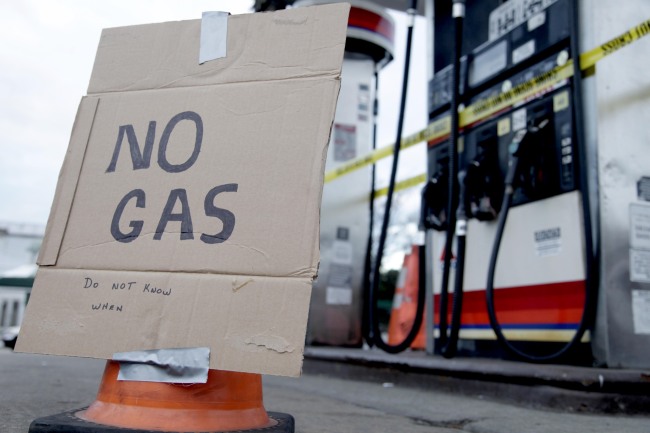 |
A sign indicates that fuel has run out at a gas station in the Brooklyn borough of New York on Nov. 2. (AP-Yonhap News) |
PARIS (AFP) ― Hit by the shocks of hurricane Sandy and recession in much of Europe, world oil demand is set to fall further than earlier forecast in 2012, the International Energy Agency said on Tuesday.
In its monthly report on the world oil market, the Paris-based IEA now believes global demand will increase by 670,000 barrels a day in 2012 to 89.6 mbd. This is 60,000 bpd less than assumed a month ago.
For 2013, the IEA slashed its demand forecast by 100,000 bpd to a rise of 830,000 bpd to reach 90.4 mbd.
The downward revisions are due mainly to sluggish economies in developed OECD countries and the knock-on effects of Hurricane Sandy which wrought havoc on the U.S. eastern seabord three weeks ago.
Sandy is expected to have slashed U.S. demand by 230,000 barrels per day in October, as people curtailed travel and product deliveries were impeded.
For 2012, U.S. demand will dip by 310,000 bpd to 18.7 mbd, the same 12-month total forecast for 2013, the IEA said.
The other drag on demand was Europe, where the effects of the eurozone debt crisis have pushed much of the region into recession.
Overall, European demand in the third quarter is 150,000 bpd lower than the previous estimate, the IEA said, “as the already bleak outlook was with hindsight too optimistic.”
In Europe, the IEA envisages a 500,000 bpd contraction in demand this year to 13.8 mbd followed by another contraction of 200,000 bpd in 2013 to 13.6 mbd.
Demand in powerhouse China, the world’s biggest energy consumer, was on the otherhand revised slightly upwards for 2012 to 9.5 million bbd up by 260,000 bpd from the precious forecast. Chinese demand in 2013 will be 9.8 mbd, a moderate increase.
On the supply front, floods in Nigeria pushed OPEC oil output in October to the lowest level for nine months, down 30,000 bpd to 31.15 mbd.
Demand from China and South Korea helped sanction-hit Iran marginally reverse a downward trend, with output rising by 70,000 to 2.7 mbd.
Iraqi oil output was modestly higher in October with the Kurdish-dominated north accounting for most of the rise as ports in the south were affected by weather problems.
Saudi and Kuwaiti output also inched up in October, but Libya production dipped, hampered by “civil unrest and operational issues,” the IEA said.
Output in non-OPEC countries “rebounded strongly” in October to 53.4 mbd ― a 840,000 bpd rise ― after maintenance in Brazil and the North Sea and Hurricane Isaac in North America negatively impacted output in September.








